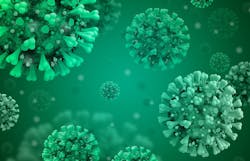Scientists in Columbus, Ohio, discovered a new variant of SARS-Cov-2, which carries a mutation identical to the strain that first emerged in the United Kingdom, but it likely arose in a virus strain already present in the United States, according to a press release from The Ohio State University Wexner Medical Center. The researchers also report on the evolution of another U.S. strain that acquired three other gene mutations not previously seen together in SARS-CoV-2.
These findings, which were made by researchers at The Ohio State University Wexner Medical Center and College of Medicine, are under review for publication in BioRxiv as a pre-print. The medical center has been sequencing the genome of SARS-Cov-2 viruses in patients with COVID-19 since March 2020 to monitor the evolution of the virus.
The new variant was discovered in one patient from Ohio, so researchers do not yet know the prevalence of the strain in the population. In contrast, the evolving strain with the three new mutations has become the dominant virus in Columbus during a three-week period in late December 2020 and January 2021
“This new Columbus strain has the same genetic backbone as earlier cases we’ve studied, but these three mutations represent a significant evolution,” said study leader Dan Jones, MD, PhD, Vice Chair of the Division of Molecular Pathology. “We know this shift didn’t come from the U.K. or South African branches of the virus.”
Like the U.K. strain, mutations detected in both viruses affect the spikes that stud the surface of SARS-Cov-2. The spikes enable the virus to attach to and enter human cells. Also like the U.K. strain, the mutations in the Columbus strain are likely to make the virus more infectious, making it easier for the virus to pass from person to person.
The scientists said that discovery of the Columbus variant, COH.20G/501Y, suggests that the same mutation may be occurring independently in multiple parts of the world during the past few months.
“Viruses naturally mutate and evolve over time, but the changes seen in the last two months have been more prominent than in the first months of the pandemic,” Jones said. His team has been conducting Ohio State’s genetic sequencing on environmental and patient SARS-CoV-2 samples, and he’ll continue to monitor for changes as vaccination occurs.

